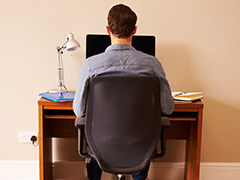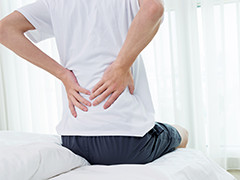Keeping Low Back Pain At Bay

A sore back can sideline even the healthiest person. Four out of five people experience back pain at some point, the second most common reason for visiting the doctor. The bright side is that 30 to 60% of people with low back pain make a full recovery within 1 week and 80 to 90% of people make a full recovery within 6 weeks. We put together some simple strategies to help avoid low back pain and treat it from the comfort of home.
Causes
The spine is an amazing structure but also a delicate one. There are lots of factors than can contribute to low back pain and we’ve detailed the most common below.
- Lack of exercise – if your back is hurting, a little rest is always a good idea. But regular physical activity is important as it can help ease inflammation and muscle tension.
- A few extra pounds – some extra weight, especially around your middle, can make back pain worse by putting strain on your lower back. It’s a good rule of thumb to stay within 10 pounds of your ideal weight.
- Smoking – smoking restricts blood flow to spinal discs making smokers especially vulnerable to pain.
- Bad posture – hunching, slouching and leaning can all cause low back pain. While you may get carried away with work from time to time, it’s good to take a minute for a posture reset. You can also purchase a chair with a straight back or low back support to keep your knees a bit higher than your hips while seated.
- The wrong bag or briefcase – if you carry a bag or briefcase, try to find one with a wide adjustable strap that can reach over your head. Having a strap on the opposite shoulder of the bag distributes weight more evenly and helps keep your shoulders and back pain-free.
At-home remedies
A trip to the ER can be costly and in the event of non-life threatening back pain, unnecessary. Try a few of these at home remedies to ease low back pain.
- Over-the-counter (OTC) medications – ibuprofen and acetaminophen may help relieve pain instantly or soothe symptoms while you give your back a rest for a few days.
- Light exercise – a short walk, yoga or other low impact activities can often help relieve back pain. Exercise loosens tense muscles and releases endorphins.
- Heat and cold – ice packs are best used following an injury. Wrap in a towel and apply directly to the back to reduce inflammation. A heating pad can also be used to relieve stiff muscles.
- Stretch – stretch for 30 seconds at a time or as long as you feel comfortable. Touch your toes or lay in child’s pose to loosen things up.
- Creams – a variety of pain-relief creams are easily found in pharmacies. Creams that contain capsaicin or menthol can temporarily dull back pain while you recover.
If you experience chronic or severe back pain, you may want to have a conversation with your doctor. Always consult with your doctor before starting an exercise plan. Our telehealth services are a convenient way to connect with a Preferred provider, especially when you are resting or recovering from low back pain.


